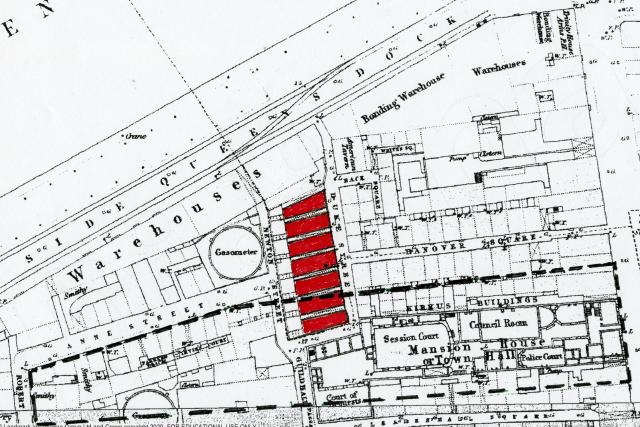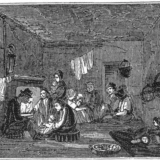Dealing with Contagious Fever in Georgian Hull

Location of Duke Street.
1850 map showing the Duke Street houses coloured red and the outline of present Guildhall and Law Courts marked in black dashed line
In 1803 Miss Jane Horner sent an account of a contagious fever at Kingston-upon-Hull to the “Society for Bettering the Condition and Increasing the Comforts of the Poor”. Jane Horner, (1757-1828), lived with her bachelor brothers Simon and John Horner, wealthy merchants, at 28 High Street, Hull. [Site now in Mandela Gardens, next door to Oriel Chambers] They were considered an ‘eccentric family’, particularly Simon Horner whose ‘greatest pleasure was in silently securing happiness and relieving the wants of his poorer fellow creatures’.
Miss Horner’s account begins: ‘In the winter of 1801, the typhus fever prevailed in Duke-street at Hull, and spread by contagion to other parts of the town … Tho’ Duke-street is not in a confined situation, and the houses are newly built, and only seven in number; yet each house contains eight rooms, and, with only three exceptions, every room a family. The rooms in which the fever prevailed, were close and crowded; the ceilings, walls, closets, and floors, were uncommonly dirty; and the beds, bedding, and furniture, in the same state. The air in them was suffocating and offensive; the crevices of the doors and windows were filled up with old linen or paper, and the landings were crowded with vessels of foul water. In these seven houses, there are 51 families, and 200 inhabitants. Many of the heads of these families are mechanics, as shoemakers, tailors, &c and follow sedentary occupations at home. The children were likewise confined at home by the cold weather. The fever raged in 32 of these families; in six of them, before the medical gentlemen began their attendance; seventeen persons having had the fever, nine of whom died. Four of these were fathers of large families, five were mothers, and the remaining eight were children. Of one family the father and mother both died, and left five orphans, who were taken into the workhouse. In another, the father died, leaving his widow pregnant, who, with six small children, must now chiefly depend on parochial relief. In the 26 families that Dr. Crosley attended, 70 persons had the fever; nine were fathers, 21 were mothers, and the remainder children. Many of them were in very great danger, but they have all recovered.
The fever in itself was very infectious; but the spreading of the contagion was much increased by idle, ignorant, and officious neighbours crowding the rooms of the sick; some sitting two hours and more at a time. By this practice they not only disturbed the patients, and rendered the air of the apartments less salubrious, but often carried the infection home to their own families. Many of them could name the time when, and place where, they caught the infection; and it was traced from one room to another in several families: to these acts of imprudence they added others equally dangerous. When any one died, the body was kept [in the room] three days, exposed to the sight of every prying neighbour; and the funeral particularly if on a Sunday, was attended by a great part of the inhabitants of the street.
The following plan was adopted to destroy the contagion, and to relieve the sick. The street was paved anew, the drains, which were defective, repaired, and a proper descent given to carry off the foul water. The ceilings, walls, and closets of the rooms were sashed with quick-lime fresh from the kiln, and the furniture and floors with soap and cold water. The bedsides were washed every morning, and the floors sprinkled with vinegar twice a day. The doors and windows were set open every day three or four times, between ten o’clock in the morning and four in the afternoon. Steady and attentive nurses were engaged to wait on the sick; and they were charged neither to suffer strangers to come into the rooms, nor to go into the apartments of other families. (Four nurses and two superintendents who were engaged to attend the sick, and to take charge of the linen and other articles, caught the fever, but recovered. The workhouse surgeon, who only visited the sick a few times, took the infection and died.)
Sheets, blankets, and rugs were provided, that the sick might lie warm and comfortable; and body linen to keep them clean in their persons. The dirty linen taken off the beds and bodies of the patients, was immediately put into cold water; afterwards washed, and dried without doors; and everything was speedily removed, that had a tendency to accumulate the contagious miasm. The hands of the patients were washed night and morning, and their mouths cleansed frequently with vinegar and water. Coals were provided for those, who had not the means to buy them. The sick and their families were supplied with arrow root, sago, or boiled milk for their breakfast; and good mutton broth was boiled every day for dinner; each family, according to the number it contained, receiving two, three, or more quarts daily, at 12 o’clock at noon. Good wheaten rolls, one day old, were distributed at the same time among the families, and in the same proportion; rice pudding, a little boiled mutton, or beef-steak, with half a pint of brisk small beer or ale, were allowed the convalescents. Milk, sago, ale caudle, or arrow root, was prepared and given in the evening. In the worst stages of the fever, wine was sometimes the only thing that could be taken; and with this the patients were supplied in small quantities every half hour, hour, or two hours, as the case required…….
The contagion was entirely destroyed and the fever perfectly subdue in little more than two months. The whole expense of supporting during this time, twenty-six families, containing one hundred and fifteen persons, of whom seventy had the fever, did not much exceed £200. The fever was particularly dangerous in the cases of adults …’
[Footnote by another states: We can add to this account (from good authority) that the poor of Hull have been under the greatest obligations to the writer of this extract [Jane Horner], and her two brothers, for the charitable aid they have been constantly giving to the distressed and needy. But during the late calamity, the sick families in Duke-street were infinitely indebted to them for the uncommon pains they took to promote the comfort and recovery of the sick, and the support of their families. They sought out careful, steady, and attentive nurses, gave them instructions and paid them wages; they kept the account of the wine other expenses; they directed and superintended the making of the mutton broth, sago, and other articles of diet, and they frequently sent provisions to the sick from their own tables. B 17th Dec. 1803]
Duke Street was a short street on the south side of Queen’s Dock. It ran across the west end of Hanover Square (the street on the north side of the Guildhall). Named after William Duke, who owned the site, it was laid out in the 1790s. At that time it ended to the south on the Town Hall and Sessions Court; the south part is now under the present Guildhall, the rest was demolished in the early 20th century. An opening at the west end of the former warehouses on the south side of Queen’s Gardens is the last surviving reminder of the street. The seven houses stood on the west side of the street.
Jane Horner, author of the above account of the typhus fever, died aged 71 in September 1828 at Middlesmoor, a small village at the very head of Nidderdale, where the Horner family originated. She may have been on a visit to the family home Woodale Hall.
The Horners were involved in lead mining in Nidderdale from at least the 17th century. From then onwards there were one or two members of the family resident as merchants in Hull, from where their lead was exported to Europe. For three generations the male Horners living in Hull bore the Christian [names Simon and John. Simon Horner (d. 1829), uncle of Jane, purchased the Sunderlandwick estate, near Driffield, which he passed to his nephew Horner Reynard.
David Neave May 2020
 Interior of a nineteenth century slum 1
Interior of a nineteenth century slum 1 Interior of a nineteenth century slum
Interior of a nineteenth century slum

